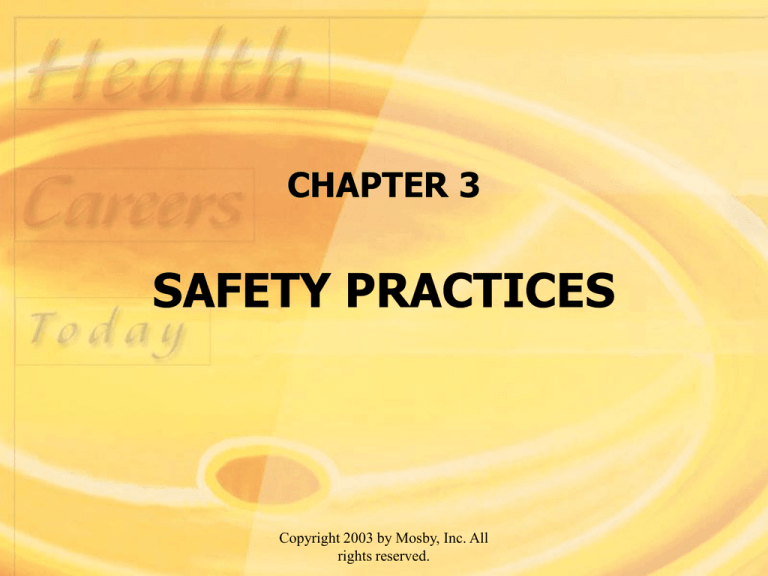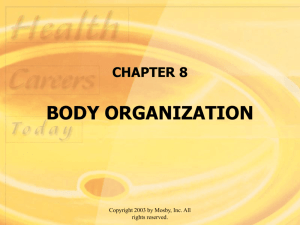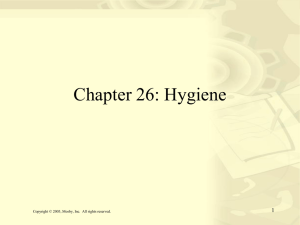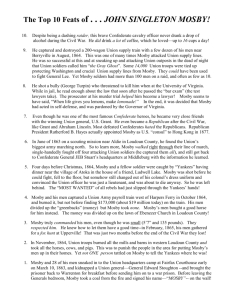
CHAPTER 3
SAFETY PRACTICES
Copyright 2003 by Mosby, Inc. All
rights reserved.
Disease Transmission
Microorganism- can not be seen with the
human eye
Pathogen is a microorganism that causes
disease; bacteria, fungi, virus etc.
*Infection requires three elements
– Source of microorganisms that is a pathogen
– A susceptible host
– A means of transmission to the host
*Nosocomial Infection-____________________
____________________________________
Copyright 2003 by Mosby, Inc. All
rights reserved.
Methods of Transmission
• Contact
– Direct or indirect through an inanimate object
• Droplet
• Airborne
• Common vehicle
– Water, food, contaminated equipment
• Through vectors
– Mosquitoes, flies, rats, and other such vermin
**Equipment /work surfaces must be cleaned when they are
visibly contaminated or at the end of the day
Copyright 2003 by Mosby, Inc. All
rights reserved.
Infection
•
•
•
•
•
Symptomatic
Asymptomatic- No symptoms
Local infection is limited to a small area of the body
Systemic infection is located throughout the body
Signs and symptoms of a general infection include
fever, chills, pain, an ache or tenderness, general
feeling of tiredness, and night sweats
• Signs and symptoms of a local infection may include
redness, heat, swelling, pain, or fluid
Copyright 2003 by Mosby, Inc. All
rights reserved.
Isolation Precautions
2 levels of precautions established by the Hospital
Infection Control
• Standard Isolation Precautions (Universal
Precautions) are applied to ALL patients; designed to
reduce the transmission of microorganisms both
diagnosed and undiagnosed
• Transmission-Based Precautions are applied to
patients with known or suspected infections
PERSONAL PROTECTIVE EQUIPMENT (PPE)gloves, gowns, eyewear, footwear, masks, headwear
-An mask and eye protection must be worn if fluids can
splash or spray
Copyright 2003 by Mosby, Inc. All
rights reserved.
Table 3-1 Isolation
Precautions
Copyright 2003 by Mosby, Inc. All
rights reserved.
Box 3-2 Requirements of
Standard Precautions
Copyright 2003 by Mosby, Inc. All
rights reserved.
Box 3-3 Bioterrorism Agents
Bacteria Classification:
1.
Shape
*Spirilla- spiral
*Staphylococci are round and cause impetigo
and boils
*Diplococci- paired
*Streptococci- chains
*Bacilli are rod-shaped
2. Anaerobic
3. Aerobic
Copyright 2003 by Mosby, Inc. All
rights reserved.
Types of Microorganisms that are
pathogens
• Bacteria
• Fungi
• Protozoa
• Rickettsiae (parasites)
• Viruses
*Not all microorganisms are pathogens
Copyright 2003 by Mosby, Inc. All
rights reserved.
Handwashing Technique
• Hands are washed thoroughly at the
beginning of the work period
– Between each client contact
– Before and after eating
– Before and after using the restroom
– Before leaving the work environment
• Gloves are worn when contact is made with
body fluids, mucous membranes, or wet
secretions
Copyright 2003 by Mosby, Inc. All
rights reserved.
Principles of Asepsis
• Medical asepsis can be evaluated on three levels
– Antiseptics, which inhibit the growth of bacteria;
they can be used on the skin
– Disinfectants are agents that destroy most
bacteria and viruses. They can be caustic or
harmful to the skin. Disinfection can be
accomplished by boiling as well as by using
chemical agents.
– Sterile, also referred to as surgical asepsis, is a
state of sterility or the use of sterile technique
-removes all microorganisms
-use of an autoclave
-isolation of a patient
Copyright 2003 by Mosby, Inc. All
rights reserved.
Occupational Safety and Health Administration
(OSHA) Regulations
• Established in 1970
• To establish standards of safety for the workplace
and to enforce the standards
• To research and provide documentation to OSHA
regarding the safe level of exposure to hazards in the
workplace
• Employee exposure protocol= 2 hours to report
Ex of OSHA for patients: requires all tattoo parlors to
have a health dept permit; must have consent
before performing a tattoo or piercing; tetanus is
possible contamination with tattoos
Copyright 2003 by Mosby, Inc. All
rights reserved.
Box 3-4 Material Safety Data
Sheet
OSHA- “Right to Know” for employees
Copyright 2003 by Mosby, Inc. All
rights reserved.
Body Mechanics
Several important ergonomic reasons for the elevated ergonomic injury rates are
inherent in healthcare facilities services including many sources of "high
ergonomic demand" work activity such as: frequency and amount of weight
lifted; static exertion; simultaneous lifting, flexing and twisting; and sudden,
unexpected loading.
A significant number of the healthcare workers (HCWs) performing these "high
ergonomic demand" maneuvers are women who are routinely placed under
heavy physical demand, such as lifting a 150 pound patient, when the limit
considered safe for 75% of the female HCW workforce is approximately 50
pounds.
Copyright 2003 by Mosby, Inc. All
rights reserved.
FACTS
*Compared to other private industry sectors, the injury rates for employees in
healthcare facilities are often higher than the injury rates for other
businesses in the United States.
*This most recent U.S. Department of Labor (DOL) summary statistics for
2001 indicate that nursing aides, orderlies and attendants, along with two
other occupations (truck drivers and nonconstruction laborers), account for
one out of five musculoskeletal disorders reported nationally in 2001.
*The American Nurses Association reports that ergonomic injuries occur in
nurses at a rate that is twice that found in the general working
population and that up to 38% of the current nursing workforce has been
affected by a back injury.
*The U.S. DOL statistics summarizing 2000 workplace injury and illness data
indicate that nursing aides, orderlies and attendants are listed as the second
most likely occupation to sustain ergonomic injuries requiring the most
time away from work.
Copyright 2003 by Mosby, Inc. All
rights reserved.
Safe Movement
• Body mechanics
– Refers to the way the body is moved to prevent
injury to oneself and to others
– Accomplished by using knowledge of proper body
alignment, balance, and movement
– Posture is the position of body parts in relation to
each other
– Balance is the ability to maintain a steady
position that does not tip
Copyright 2003 by Mosby, Inc. All
rights reserved.
Symbols of Access
• Wheelchair ramps
• Doors are wide enough to
accommodate a wheelchair
• Elevators have Braille indicators
• Telephones and drinking fountains are
placed at a lower height
Copyright 2003 by Mosby, Inc. All
rights reserved.
Identifying and Reporting
Hazards
• A fire may be controlled or extinguished
• Oxygen and electrical equipment may be
turned off
• Four classes of chemical fire extinguishers
– Class A: for use on paper, wood, trash, cloth,
upholstery, rubber, and similar materials
– Class B: for use on fuel oil, gas, paint, solvents,
and other flammable liquids
– Class C: for use on electrical equipment, fuse
boxes, wiring and appliances
– Class D: for use on metals
Copyright 2003 by Mosby, Inc. All
rights reserved.
Using a Fire Extinguisher
•
•
•
•
P- pull pin
A- Aim at base of fire
S- Squeeze handle
S- Sweep nozzle from side to side to
displace oxygen away from fire
Copyright 2003 by Mosby, Inc. All
rights reserved.
Fire Emergencies
• R- Rescue
• A- Alarm
• C- Contain (close windows and
doors)
• E- Evacuate (GET OUT)!!!
Copyright 2003 by Mosby, Inc. All
rights reserved.
Hazardous Waste
• Waste is divided into two categories
– Biomedical
• Hazardous and infectious waste is placed
in sealed bags before removing it from
the area of use; the bag is labeled and
sealed to alert workers; sharps
containers are used for needles, razors and
glass
– General
Copyright 2003 by Mosby, Inc. All
rights reserved.
Emergency Disaster
Procedures
• Caused by nature or man
–
–
–
–
Tornados
Explosions
Plane crashes
Earthquakes
Copyright 2003 by Mosby, Inc. All
rights reserved.








